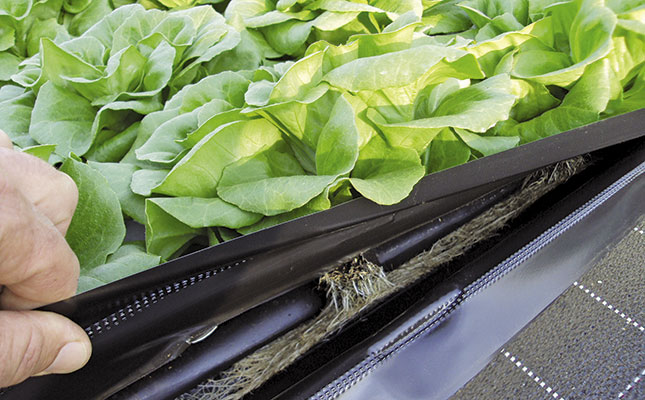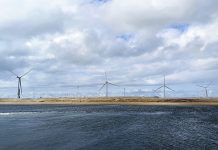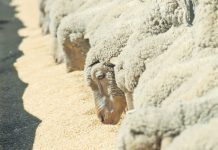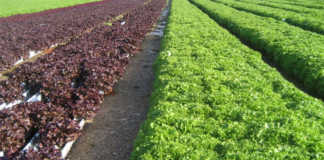
The New Growing System (NGS), like many of its competitors, is a recirculating hydroponic production system that can be used for almost any greenhouse crop, from tomatoes to flowers. What makes it decidedly different is that it requires no water sterilisation at all.
Martin von Holdt, owner of Greener Solutions, which distributes and installs the NGS in South Africa, first saw the technology in use on a farm in Spain. It has operated here on 40ha for more than 16 years, without steriliser ever being used or the producer encountering problems.
The secret lies in the design: a trough system consisting of three layers. Seedlings are planted in pre-cut holes in the first layer. Their roots grow into the second layer, which is in a ‘V’ shape to allow for good drainage. The drainage water flows into the third layer, from where it is recycled. The depth and width of the second layer varies according to the crop – for tomatoes it is about 21cm deep and 12cm wide, for lettuce 12cm deep and wide, and for strawberries 27cm wide and 22cm deep.
“No sterilisation is required, because the water, supplied via drip irrigation in the top layer, cascades down through the other layers,” says Von Holdt. “This waterfall effect oxygenates the water and helps prevent anaerobic conditions, which are associated with the accumulation of pathogens, from developing.”
He presented the NGS at the Undercover Crop Symposium in Cape Town recently. Von Holdt adds that although contamination might still occur as a result of air and dust particles or by other means, the oxygenated water ensures that the contamination level remains below the acceptable threshold.
The need for sterilisation is further reduced because the water runs rapidly through the system and is not exposed to sunlight. The water also remains cool, which prevents oxygen depletion and inhibits pathogen build-up.
However, Von Holdt emphasises the importance of using good quality water from the outset, as is required in any hydroponic production system, as the NGS cannot correct problems with poor quality water.
Other savings
The NGS uses water and fertiliser more efficiently than other open hydroponic systems in South Africa, according to Von Holdt. The traditional hydroponic lettuce growing system uses up to 75 000l/ha daily, whereas the NGS uses one-fifth to one-sixth of this as the water is recycled. All that is required is that the cistern of the NGS be emptied once a month to prevent salt build-up.
This water can be used on other open field crops that are less sensitive to salt. The system is also energy-efficient, as water is not continuously circulated. It can be set to five-minute cycles running every 10 minutes during higher temperatures, or four-hour cycles at night.
No growth substrate
Crops grown in the NGS require no growth substrate, with the exception of strawberries, for which perlite or coco peat can be used. The top layer is pre-cut and crops can be grown from seedlings or seed blocks. The slits for peppers, cucumbers and tomatoes are about 40cm apart, while those for lettuce are 10cm apart.
“Farmers will probably plant lettuce only every 20cm, but the 10cm design allows for other crops that may need closer spacing,” Von Holdt explains.
Since no soil is used, there is no weed problem, making the NGS labour-efficient. Crops can easily be lifted from the planting openings, roots-and-all, and the trough is immediately ready for replanting. The system allows for a good growth rate and some of the softer lettuce types (not iceberg) can be market-ready within four weeks or less in summer.
The trough is made from plastic supported by a steel frame. According to Von Holdt, installing the system is straightforward, and most farmers will be able to do it themselves. Assistance may be required with constructing the pump room.
The length of the trough system can be varied to suit the tunnel length, as water runs vertically through the root system. A floor surface slope of about 2% is ideal for water flow, but any slope of between 1% to 4% would be adequate. If the floor is completely level, trough supports can be modified to create an ideal slope.
For most crops, the system is placed on the floor but it is raised for strawberries. The rows can be set up to be either movable, fixed (lettuce), or oscillating (strawberries). Movable rows allow the farmer to use space more efficiently and produce more plants than is possible in fixed systems. The plastic used for the troughs has a three-year guarantee, but Von Holdt estimates that it will last about five years before it needs replacing.
The system was developed and patented by the Spanish agricultural group, Primaflor, which exports salad greens to the rest of Europe. Von Holdt says that SA farmers have been slow to take to the concept because they have been unaware of it.
“At the moment, only three farms in the country are using it, so it covers a total of about 10ha. All three are planning to
expand, however, so that by next year the system will be in use on almost 30ha,” he explains.
Financial barrier
Another difficulty is the high cost of the NGS. The most expensive variation – for lettuce – costs about R3,5 million/ ha, compared with about R2 million/ ha for a fixed system, which excludes the pump and accessories at about R500 000. For tomatoes, a more sophisticated system costs about R1,5 million/ ha excluding the pump system. Von Holdt estimates, however, that a system will pay for itself in three to four years, depending on the crop.
A producer’s experience
Milane Farms near Pretoria has been using the New Growing System on 1ha for three months. Milane Farms is part of In2food, a company specialising in prepared foods. Namhla Skweyiya, Milane Farms general manager, says they decided to use this system for the production of salad greens as it had proved itself in Spain.
“It isn’t a difficult system to operate, but as with anything new, we experienced growing pains. But our production shows we’ve overcome these,” she says. Skweyiya adds that one of their worst mistakes was to plant on the dripper line, instead of next to it. Many plants dried out because they did not have access to water. Fortunately, an NGS consultant noticed the problem before it was too late.
Skweyiya admits that the system is expensive, but says that it pays for itself in a short time by saving on labour, having short production cycles and ensuring high yield. Milane Farms would buy more tunnels if they could afford to and they are happy to recommend the system to other farmers. Skweyiya stresses, however, that farmers must ensure they have a secure source of water and electricity.
Phone Martin von Holdt on 043 732 1023 or email [email protected]. Visit www.ngsystem.com/en













